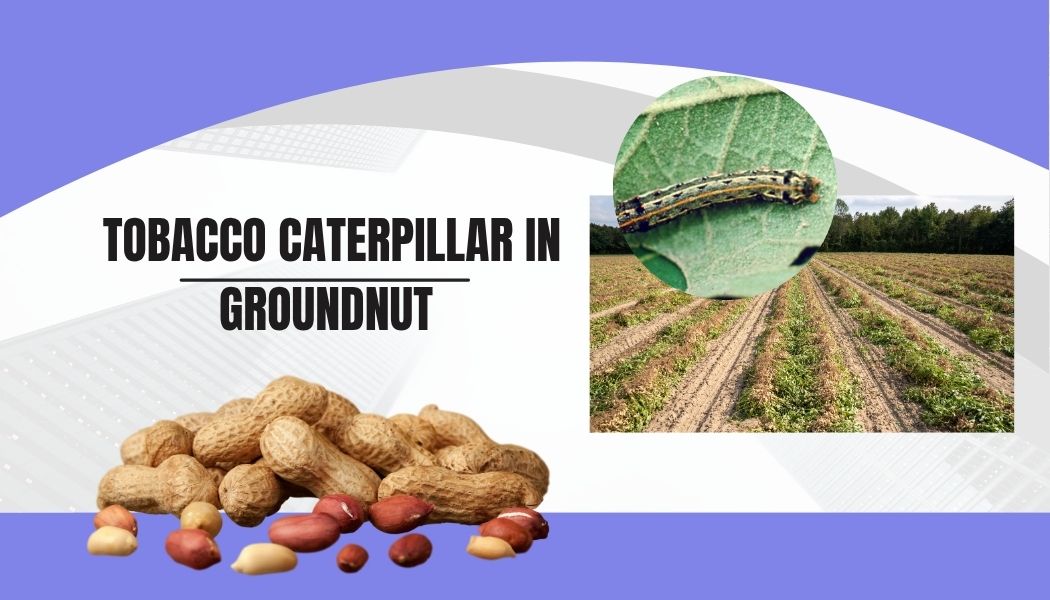
TOBACCO CATERPILLAR IN GROUNDNUT
Telugu name: Pogaku ladde purugu
Scientific name: Spodoptera litura
Identification of pest
1. Egg Stage:
Eggs are laid in clusters, covered with hair or scales, often on the underside of leaves.They appear creamy white initially and turn darker as they mature.
2. Larval Stage:
Caterpillars are pale green initially and turn brownish with black and white stripes along the body.Fully grown larvae measure about 3-4 cm in length.
3. Pupal Stage:
Pupation occurs in the soil inside a silken cocoon.
4. Adult Stage:
Moths are medium-sized, with brown forewings marked with wavy patterns and whitish hindwings.
Life cycle:
The adult female moth lays eggs in masses of 200-300 on the underside of the groundnut leaves. The egg masses are approximately 4-7 mm in diameter, brown in colour and are covered with body hair. Eggs usually hatch after 3- 4 days. Fully grown caterpillars measure about 3-5 cm in length.
Symptoms:
- Scrapping of the leaves by freshly hatched larvae.
- Grown up larvae feed the entire leaf leaving petioles alone looks the field grazed by cattle.
- Since this pest is nocturnal in habit larvae hide under the plants, cracks and crevices of soil and debris during the day time.
- Faecal pellets are seen on the leaves and on the ground which is the indicator of the pest incidence.
Favorable Conditions:
- Warm and humid weather.
- Monsoon and post-monsoon periods are favorable for outbreaks.
- Dense vegetation favors rapid population build-up.
Economic Threshold Level (ETL)
Control measures should be initiated if:
- 8 larvae per square meter in the field.
MANAGEMENT
Cultural Control
- Removal of weeds and alternate hosts.
- Follow summer ploughing to expose pupae to sunlight and bird.
- Grow castor as a border (or) intercrop to serve as an indicator (or) trap crop.
- Collect and destroy egg masses, early stage larvae with lace-like leaves.
- Avoid larvae migration by digging a trench of 30cm deep and 25cm wide with perpendicular sides around the infested fields.
Mechanical Control
- Install light trap @ 1 /ha to monitor moths activity.
- Install pheromone traps @ 5 / ac to monitor and kill male moths.
- Biological Control
- Release of natural enemies such as:Trichogramma chilonis (egg parasitoid).
- Predators like Chrysoperla carnea (green lacewing).
Chemical Control
- Application of insecticides when larvae population exceeds the economic threshold level (ETL: 8 larvae/m²):
- Spinosad @ 0.2 mL/L.
- For effective control of Caterpillar in groundnut bio pesticide like “LARVEX 250 ml / acre” can be used.
FAQ’s
1.How can I identify tobacco caterpillars in groundnut crop?
Large greenish-brown caterpillars on leaves and pods, skeletonized leaves, and boreholes in pods. Check your crops early in the morning or evening when they’re active.
2.What’s the best time to scout for tobacco caterpillars?
Early morning or late evening is ideal. Regular weekly scouting is important during the cropping season.
3.Which chemical control methods best for controlling tobacco caterpillars?
Insecticides like chlorpyrifos or spinosad can be used,.For effective control of tobacco caterpillar LARVEX 250ml/acre can be used.
4.How can I prevent tobacco caterpillars from infesting groundnut crop?
Practice crop rotation, avoid planting after host crops like cotton, and ensure timely weeding to reduce their food sources.
5.Are tobacco caterpillars harmful only to leaves?
No, they damage both leaves and pods, reducing yields significantly if not controlled early.
